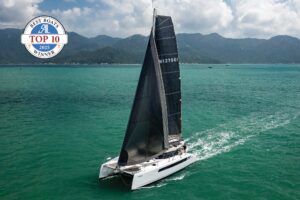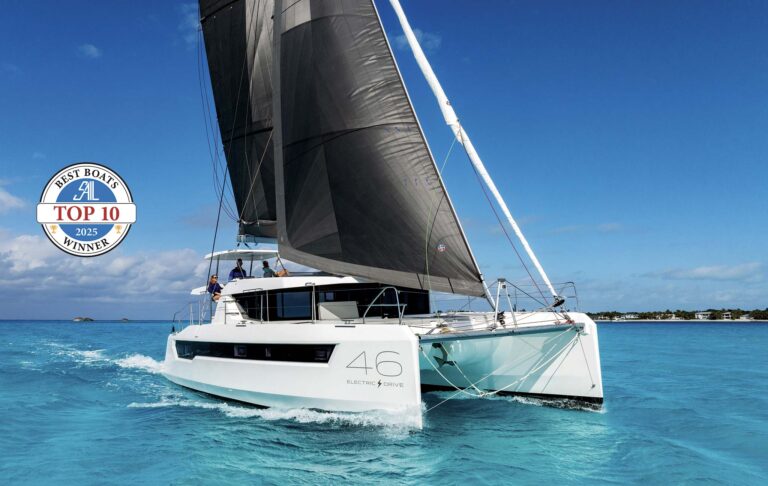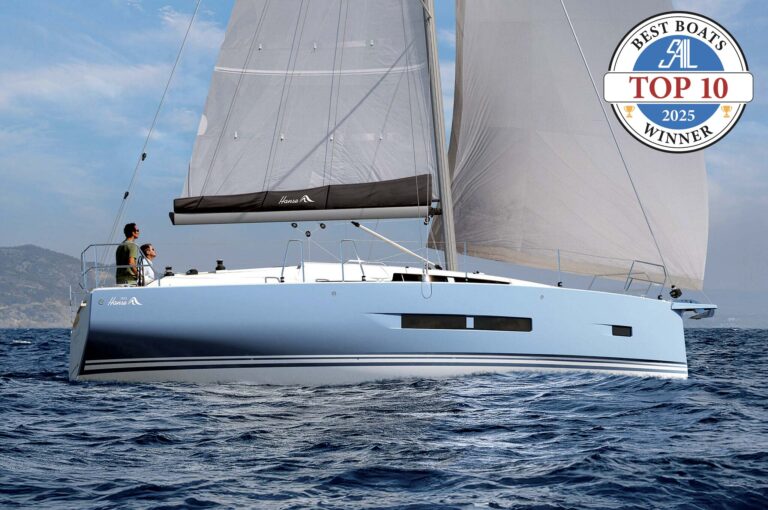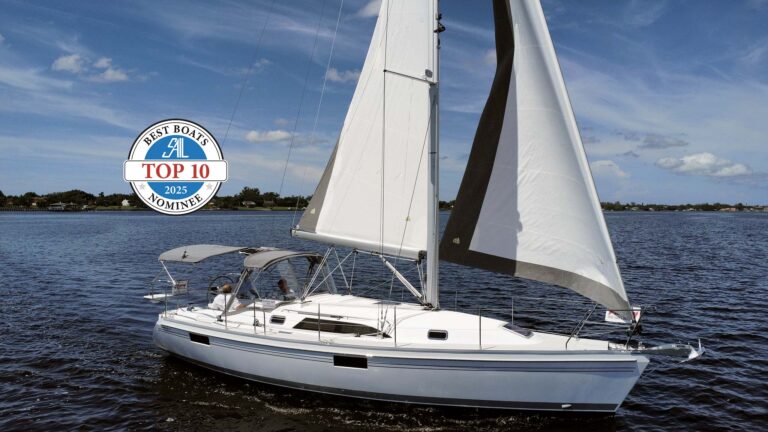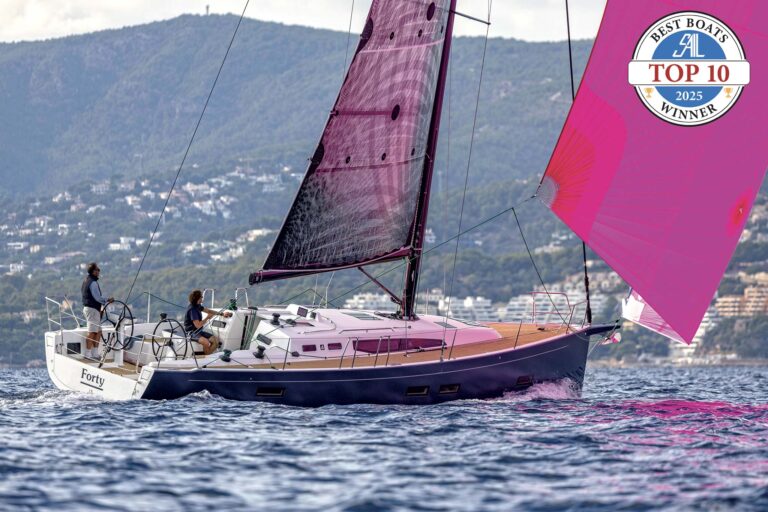
The Lagoon 52 represents a new direction in big boats for this respected French catamaran builder. Using new performance criteria, VPLP Design has created a family of faster vessels that also happen to have dramatic looks and great strength. The 52 would make a fine voyager for two couples or a family that wanted to cross oceans rapidly and in style. With several of the alternate layouts, it would also be a luxurious charter craft.
CONSTRUCTION
Although you might not immediately notice the differences between this boat and its predecessors, they are dramatic. For example, moving the mast back to the 43 percent point to get a larger foretriangle required moving the center of buoyancy of the hulls aft as well. That, in turn, meant reshaping the hulls and making the bows sharper, not to mention adjusting the overall center of lateral resistance to keep the boat balanced with the big jib and small mainsail.
Moving the mast aft also required some kind of new support, as the main bulkhead at the forward end of the saloon is no longer usable as a base. That meant creating an entirely new support structure: which Lagoon has done in the form of a big, stiff, reinforced grid concealed within the cabin and hull, and a strong compression post in the middle of the boat
Putting the helm up on a flybridge created yet more structural challenges due to the strains of the running rigging and the weight of people up there. Finally, the short boom (another result of the aft position of the mast) calls for a taller rig to replace the lost sail area.
Amazingly, all of it works on the Lagoon 52: the tall rig is efficient; the mainsail is easy to trim, raise and furl (although the standard electric halyard winch is still essential); the roller-furled headsails behave nicely; and the boat really goes. VPLP Design got it right.
Lagoon has always built strong boats, and I found no deck flexing or noise during our test sail. The vacuum-infused balsa-cored hull and deck (solid glass below the waterline) should enjoy a long service- life. The interior liners are solid glass or core-mat sandwich, and the joinery is an Alpi wood surfaced laminate. As always, this builder installed the electrical and plumbing systems properly and provided good access to the systems and to the engines.

ON DECK
The deck layout of the Lagoon 52 is unique, with all the action happening on a big flybridge, one flight upstairs from the passenger cockpit and far above the water. Passengers who prefer to enjoy the ride quietly or converse with others can lounge in the cockpit below or sit sunning on the bows as the dolphins arc past.
A big pedestal is smack in the center of the flybridge, with the electronic displays spread out ahead. Just so the driver doesn’t go cross eyed from having the mast squarely in the line of sight, the wheel can be flipped into three positions: starboard, port and center.
Since the helm station is right at the base of the mast, halyards and sheets fall naturally to hand for either the helmsman or the crew. Lagoon has also provided plenty of line-tail bags to control
the loose strings and has installed winches sized properly to their tasks.It’s an efficient, comfortable place to spend a day sailing. Because the top is hard and structural, you can walk anywhere on it. This gives outstanding access to the boom, even for shorter sailors.
ACCOMMODATIONS
Typical of Lagoons, the interior is friendly to tall sailors, not just in the saloon, but in the other cabins as well. Walk into the owner’s cabin and you’ll think you’re in an upscale hotel room. The guest accommodations are lovely, too.
In the four-cabin model I sailed, there are pleasant double-berth accommodations forward with their own head compartments and showers. The truly glamorous places to sleep, however, are in the two aft cabins, each of which qualifies as an owner’s or VIP quarters.

To starboard is a big, bright space with a large shower and sink space walled off by glass. The toilet is in a separate compartment near the dressing table. To port is another pretty space that has its own direct entry from the cockpit. I’ve seen less inviting places on 90-footers.
The central nav station enjoys a panoramic view that will make sailing during inclement weather by remote control comfortable. A large dining table and well-equipped galley complete the space. The big sliding doors make the cockpit and saloon into a single large area with no visual barriers.
Perhaps it’s my fondness for blondes, but I found the Alpi wood finish beautiful. Combined with soft, light-color fabrics and large windows, the overall effect is elegant. Teak joinery is an option.
UNDER SAIL
Because I hopped aboard the Lagoon 52 immediately after sailing its smaller sister, the 39, on the same day in the same conditions, it is impossible to resist comparing them. Even with all their design similarities, they have distinctly different personalities.
Lagoons have never been lightweight flyers with acres of sail power. In that tradition, the new boats have moderate displacement and moderate sail area, although they still manage quite respectable speeds. This is a tribute to both the designers and the builder.
Our test boat did have the optional square-top mainsail and Code Zero headsail, which powered it up quite a bit. In fact, we were at the top of the usual wind velocity for the Code Zero in 18-20 knots of wind off Miami, but we wanted to push it to see what happened. The result was a speed of 10-11 knots on a beam reach, compared to about 9 knots under the self-tacking jib. Quite a downwind ride.
During the 52’s delivery run across the Atlantic, 200-mile days were apparently common, and the best day’s run was 220 miles. The tall rig has one disadvantage: bridge clearance. It’s over 89 feet from waterline to truck, so you won’t be taking the Lagoon 52 under any standard 65-foot highway bridges.
While it was too rough to get accurate tacking angles in the seaway we experienced, the 52 did come through the wind smoothly on tacks and accelerated well out of the turns. Unlike the 39, which gave clear feedback from the rudder to the wheel, I found the 52 more difficult to keep “in the groove” and sailing at its best angle because the helm response was a bit vague.
The motion in the short 5-7 foot seas was lively. To be fair, we were going fast and encountering those waves in rapid succession, especially while sailing to windward. A comparable monohull might have given a smoother ride, simply because it was slower.
UNDER POWER
The Lagoon 52 is relaxing under power. I measured an easy 8 knots at a 2,400 rpm throttle setting, with a low (62 dBA) sound level that permitted comfortable conversation. Close quarters maneuvers were simple and predictable, with the big cat stopping, backing, turning and pirouetting exactly as it should. In many ways, the motoring experience from the flybridge of the Lagoon 52 felt like running a trawler yacht, except it is more stable, faster, quieter, more maneuverable, has bigger accommodations and burns less fuel than those popular powerboats.
CONCLUSION
The Lagoon 52 is part of a major evolutionary step for this well-established company. A new desire for speed with easy handling has brought a dramatic design change while retaining the builder’s familiar overall look. It’s easy to imagine cruising the islands in style aboard this boat and experiencing some great sailing while doing it. In the luxury catamaran market, the Lagoon 52 is a serious contender that deserves a close look if your budget is right.
OUR TAKE
SPECIFICATIONS
HEADROOM 6ft 9in

BERTHS 6ft 9 in x 5ft 3in
LOA 52ft
LWL 51ft 2in
BEAM 28ft 3in
DRAFT 4ft 11in
DISPLACEMENT 57403lb
SAIL AREA 1722ft2 (100% FT)
FUEL/WATER/WASTE (GAL) 262/253/19
ENGINE 2x54hp Yanmar with saildrive
ELECTRICAL 840AH (house)
DESIGNER VPLP Design
BUILDER/U.S. DISTRIBUTOR Lagoon America. Annapolis, MD, 410-280-2368, lagoonamerica.com
SAIL AREA DISPLACEMENTRATIO 18
DISPLACEMENT-LENGTH RATIO 191
Photos courtesy of Lagoon Catamarans


